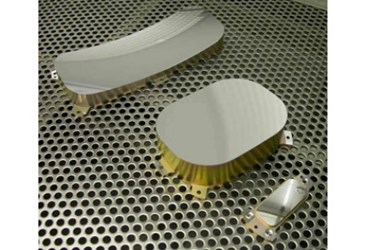Corning Optical Assembly Key Component Of NASA's New Horizons Mission Past Pluto

Corning Incorporated recently announced that a high-precision opto-mechanical assembly manufactured in Corning’s Keene, N.H., facility is part of the imaging system of NASA’s New Horizons mission that made its historic pass by Pluto Tuesday.
Corning provided diamond-turned mirrors and housing that are an integral part of the unmanned spacecraft’s Ralph infrared imager, a remote sensing instrument manufactured by Ball Aerospace to map surface composition and temperature. The Ralph imager has returned the closest-ever color images of Pluto.
The New Horizons mission, the first spacecraft to the Pluto System and the Kuiper Belt, launched in 2006 and has traveled for nine years to reach the milestone close approach to Pluto. The spacecraft traveled within approximately 7,750 miles of Pluto on July 14. The mission resulted from collaboration among NASA, the Southwest Research Institute, and industry partners. Corning’s high-precision mirrors and housing were engineered as part of the Ralph imager to deliver optical performance that is minimally sensitive to temperature and minimizes thermal gradients.
The diamond-turned mirrors enable the Ralph imager to respond passively to temperature gradients, ensuring it remains in focus. The mirrors, designed to be lightweight, help enable the Ralph imager to run with low power. Corning and Ball Aerospace worked closely to perform the assembly and detailed testing of the Ralph optical engine prior to the mission launch.
“We’ve delivered diamond-turned mirrors and optical components for several NASA missions but are especially proud as the New Horizons mission marked this important milestone,” said Curt Weinstein, vice president and general manager, Advanced Optics, Corning Specialty Materials. “Corning has a long history in space innovation, dating back more than 50 years. With our focus on innovation, we look forward to continued industry collaboration on projects like New Horizons.”
Highlights of Corning’s role in space exploration include making window glass for all of NASA’s manned space missions and the International Space Station, and production of mirrors for the Hubble, Gemini, and Subaru telescopes.
For more information about Corning Specialty Materials, please visitwww.corning.com/specialtymaterials.
About Corning Incorporated
Corning is one of the world’s leading innovators in materials science. For more than 160 years, Corning has applied its unparalleled expertise in specialty glass, ceramics, and optical physics to develop products that have created new industries and transformed people’s lives. Corning succeeds through sustained investment in R&D, a unique combination of material and process innovation, and close collaboration with customers to solve tough technology challenges. Corning’s businesses and markets are constantly evolving. Today, Corning’s products enable diverse industries such as consumer electronics, telecommunications, transportation, and life sciences. They include damage-resistant cover glass for smartphones and tablets; precision glass for advanced displays; optical fiber, wireless technologies, and connectivity solutions for high-speed communications networks; trusted products that accelerate drug discovery and manufacturing; and emissions-control products for cars, trucks, and off-road vehicles. For more information, visit www.corning.com.
Source: Corning Inc.
